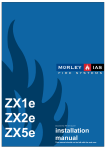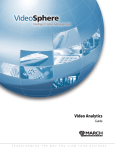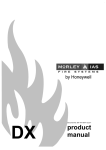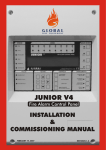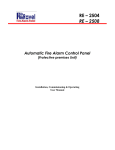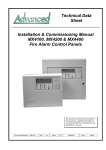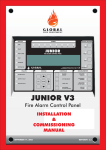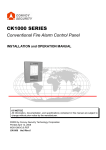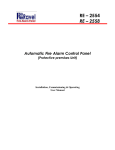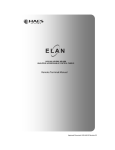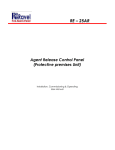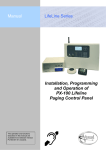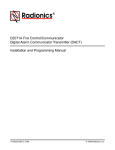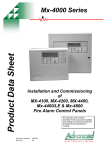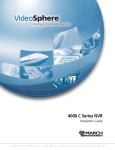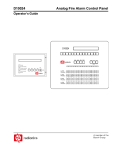Download Table of Contents
Transcript
D10024A Fire Alarm Control Panel RADIONICS Table of Contents 1 INTRODUCTION ................................................................................................................................................1 1.1 1.2 1.3 1.4 NOTICE ............................................................................................................................................................1 WARNINGS AND CAUTIONS .............................................................................................................................1 UL / NATIONAL APPROVALS ...........................................................................................................................2 EMC COMPATIBILITY .....................................................................................................................................2 2 UNPACKING .......................................................................................................................................................3 3 INSTALLATION .................................................................................................................................................4 3.1 INSTALLING THE ENCLOSURE ..........................................................................................................................4 3.1.1 Removing the Chassis .............................................................................................................................4 3.1.2 Mounting the Enclosure to the Wall .......................................................................................................4 3.1.3 Remounting the Chassis..........................................................................................................................4 3.2 IDENTIFICATION OF PARTS ..............................................................................................................................5 3.2.1 CPU Board .............................................................................................................................................5 3.2.2 Display / Keyboard.................................................................................................................................5 3.2.3 Base Card ...............................................................................................................................................5 3.2.4 Zone Extender Card (Option).................................................................................................................6 3.3 EXTERNAL CONNECTIONS ...............................................................................................................................7 3.3.1 Mains Power Input .................................................................................................................................7 3.3.2 Battery ....................................................................................................................................................8 3.3.3 Detection Loops......................................................................................................................................9 3.3.3.1 3.3.3.2 3.3.3.3 3.3.3.4 3.3.3.5 Style 4 Installation.............................................................................................................................................10 Style 6 Installation.............................................................................................................................................11 Style 7 Installation.............................................................................................................................................12 External Initiating Device Circuits ....................................................................................................................13 EMC Compliance ..............................................................................................................................................13 Sounder Circuits...................................................................................................................................................14 3.3.4.1 3.3.5 3.3.6 3.3.7 3.3.7.1 3.3.7.2 3.3.8 3.3.9 3.3.9.1 3.3.9.2 3.3.9.3 External Indicating Device Circuits...................................................................................................................15 Auxiliary Relay Outputs........................................................................................................................15 Auxiliary Supply Output .......................................................................................................................15 Panel Networking .................................................................................................................................17 Local Panel Network .........................................................................................................................................17 Panel to Superior Master Panel .........................................................................................................................17 Peripheral Loop....................................................................................................................................18 RS485 Wiring Arrangements ................................................................................................................18 Style ‘4’ Installation ..........................................................................................................................................18 Style ‘6’ Installation ..........................................................................................................................................19 EMC Compliance ..............................................................................................................................................19 3.3.10 Recommended Cables...........................................................................................................................20 3.3.11 Base Card Power Supply Connections .................................................................................................20 3.3.12 Cable Routing .......................................................................................................................................21 3.4 INSTALLING ADDITIONAL EQUIPMENT ..........................................................................................................22 3.4.1 Loop Driver Cards................................................................................................................................23 3.4.2 485 / 232 Interface Cards .....................................................................................................................24 3.4.2.1 3.4.2.2 3.4.3 4 Mounting the card directly to the base card.......................................................................................................24 Mounting the card above the Loop Driver Module ...........................................................................................24 Printer Module .....................................................................................................................................25 STANDBY BATTERY CALCULATIONS......................................................................................................26 4.1 SENSOR CURRENT CALCULATIONS................................................................................................................27 Installation Manual Document No. 996-005-001, Revision: 2 Page C.1 RADIONICS D10024A Fire Alarm Control Panel 4.1.1 Quiescent Load .................................................................................................................................... 27 4.1.2 Alarm Load .......................................................................................................................................... 27 4.2 LOCAL SYSTEMS AMPERE HOUR CALCULATION .......................................................................................... 27 5 MAINTENANCE............................................................................................................................................... 28 5.1 MAINTENANCE SCHEDULE ........................................................................................................................... 28 5.1.1 Daily Attention..................................................................................................................................... 28 5.1.2 Monthly Attention ................................................................................................................................ 28 5.1.3 Quarterly Attention .............................................................................................................................. 28 5.1.4 Yearly Attention ................................................................................................................................... 29 5.2 REPLACEMENT OF COMPONENTS .................................................................................................................. 29 5.2.1 Lithium Standby battery....................................................................................................................... 29 5.2.2 Liquid Crystal Alphanumeric Display ................................................................................................. 29 5.2.3 Standby Batteries ................................................................................................................................. 29 6 SPECIFICATIONS ........................................................................................................................................... 30 Table of Figures FIGURE 1 - ENCLOSURE ARRANGEMENT ........................................................................................................................ 5 FIGURE 2 - MAINS INPUT ARRANGEMENT ...................................................................................................................... 7 FIGURE 3 - BATTERY INSTALLATION .............................................................................................................................. 8 FIGURE 4 - SLC CONNECTIONS – STYLE 4 ................................................................................................................... 10 FIGURE 5 - STYLE 4 WIRING ........................................................................................................................................ 10 FIGURE 6 - SLC CONNECTIONS – STYLES 6 / 7 ............................................................................................................ 11 FIGURE 7 - STYLE 6 WIRING ........................................................................................................................................ 11 FIGURE 8 - STYLE 6 WIRING – ALTERNATIVE EXAMPLE .............................................................................................. 12 FIGURE 9 - STYLE 7 WIRING ........................................................................................................................................ 12 FIGURE 10 – SLC LOOP – EMC ABSORBER INSTALLATION ........................................................................................ 13 FIGURE 11 - SOUNDER TERMINAL CONNECTION POINTS.............................................................................................. 14 FIGURE 12 – SOUNDER (NAC) WIRING........................................................................................................................ 14 FIGURE 13 - RELAY OUTPUT TERMINAL CONNECTION POINTS .................................................................................... 15 FIGURE 14 - AUXILIARY OUTPUT CONNECTIONS ......................................................................................................... 16 FIGURE 15 – AUXILIARY OUTPUT - FERRITE ABSORBER .............................................................................................. 16 FIGURE 16 - TYPICAL RS485 - STYLE '4' WIRING ........................................................................................................ 18 FIGURE 17 - TYPICAL RS485 - STYLE '6' WIRING ........................................................................................................ 19 FIGURE 18 – RS485 LOOP – EMC ABSORBER INSTALLATION ..................................................................................... 19 FIGURE 19 - BASE CARD POWER CONNECTIONS .......................................................................................................... 20 FIGURE 21 - POSITIONS FOR ADDITIONAL BOARDS ...................................................................................................... 22 FIGURE 22 - MOUNTING THE LOOP DRIVER ................................................................................................................. 23 FIGURE 23 – MOUNTING THE RS485 / RS232 MODULE............................................................................................... 24 FIGURE 24 - MOUNTING THE RS485 / RS232 MODULE ............................................................................................... 24 Table of Tables TABLE 1 - MAXIMUM LOOP LENGTHS ............................................................................................................................ 9 TABLE 2 - LIST OF COMPATIBLE PERIPHERAL DEVICES ............................................................................................... 18 TABLE 3 - JUMPER SETTING FOR LOOP VOLTAGE ........................................................................................................ 23 TABLE 4 - CURRENT RATING CHART ........................................................................................................................... 26 TABLE 5 –D10024A FUNCTIONAL SPECIFICATIONS ..................................................................................................... 30 TABLE 6 - POWER SUPPLY AND CHARGER SPECIFICATIONS ......................................................................................... 31 Installation Manual Page C.2 Document No.996-005-001, Revision: 2 D10024A Fire Alarm Control Panel RADIONICS Installation Manual 1 Introduction 1.1 Notice • The material and instructions covered in this manual have been carefully checked for accuracy and are presumed to be correct. However, the manufacturer assumes no responsibility for inaccuracies and reserves the right to modify and revise this document without notice. • These instructions cover the installation of the D10024A Fire Alarm Control Panel. Refer to the User Manual (996-006-001) for instructions on powering up and operating the system. Refer to the Commissioning Manual (996-007-001) for details on programming the panel operation. 1.2 Warnings and Cautions These instructions contain procedures to follow in order to avoid injury and damage to equipment. It is assumed that the user of this manual is a suitably trained installer who is familiar with the relevant regulations. All equipment is to be installed in accordance with the appropriate standards for the country and area of installation. Electro-static Sensitive Devices. Take suitable ESD precautions when removing or installing printed circuit boards. This panel is CE Marked to show that it conforms to the requirements of the following European Community Directives: • Electromagnetic Compatibility Directive 89/336/EEC (and the amending directive 92/23/EEC) • Low Voltage Directive 73/23/EEC • This panel has been tested and found to comply with the Year 2000 requirements. • NOTE: The end date for all date functions is 31/12/2079. • In the year prior to reaching the calendar end date, consult the Original Equipment Supplier/ Current Maintenance Contractor for advice. Installation Manual Document No. 996-005-001, Revision: 2 Page 1 RADIONICS 1.3 • D10024A Fire Alarm Control Panel UL / National Approvals UL Listed for “Local” use. This equipment must be installed in accordance with these instructions, NFPA72 and the appropriate national, regional and local regulations specific to the country and location of the installation. Consult with the appropriate Authority Having Jurisdiction (AHJ) for confirmation of the requirements. 1.4 EMC Compatibility • This equipment has been tested and found to comply with the limits for a Class A digital device, pursuant to Part 15 of the FCC Rules. These limits are designed to provide reasonable protection against harmful interference when the equipment is operated in a commercial environment. This equipment generates, uses and can radiate radio frequency energy, and, if not installed and used in accordance with the instruction manual, may cause harmful interference to radio communications. However, there is no guarantee that interference will not occur in a particular installation. Operation of this equipment in a residential area is likely to cause harmful interference in which case, the user will be required to correct the interference at his own expense. • If this equipment does cause harmful interference to radio or television reception, which can be determined by turning the equipment on and off, the user is encouraged to try to correct the interference by one or more of the following measures: 1. Reorient or relocate the receiving antenna. 2. Increase the separation between the equipment and the receiver. 3. Connect the equipment into an outlet on a circuit different from that to which the receiver is connected. 4. Consult the dealer or an experienced radio/TV technician for help. Installation Manual Page 2 Document No.996-005-001, Revision: 2 D10024A Fire Alarm Control Panel RADIONICS 2 Unpacking • The D10024A Fire Alarm Control Panel is simple to install if the recommended procedures described in this manual are followed. Refer to the Commissioning Manual for details of how to program the system operation. • Before installing the D10024A Fire Alarm Control Panel, first ensure that all the equipment has been received. The packing box should contain the following items. 1. D10024A Fire Alarm Control Panel 2. Installation Manual P/N- 996-005-001 3. Commissioning Manual P/N- 996-007-001 4. Operator’ Manual P/N- 996-006-001 5. Reference Guide P/N- 996-009-001 6. Network Interface Guide P/N- 996-015-001 7. Device Compatibility Document P/N- 996-041-001 8. Front Door Keys (2 off) 9. Ferrite Absorber Kit 10. Battery Cables Kit 11. EOL Resistor • P/N- 170-073-682 (Quantity – 4) Frame and mount the supplied Reference Guide, on the wall, adjacent to the Panel. Installation Manual Document No. 996-005-001, Revision: 2 Page 3 RADIONICS D10024A Fire Alarm Control Panel 3 Installation 3.1 • Installing the Enclosure Unlock the front door and remove the battery cable, ferrite absorber and EOL resistor kits. Store these in a secure place for re-use later. 3.1.1 Removing the Chassis • Unplug the ribbon cable between the CPU Board and the Display Board at the CPU Board end. • Remove the six nuts and spring washers holding the chassis to the back box. Store these in a secure place for re-use later. • Carefully remove the chassis assembly. Store in a secure place where it will not be damaged and where it will be kept dry and clean. Handle the chassis by holding the metalwork only. DO NOT lift it by holding the printed circuit boards or any parts on the circuit boards. 3.1.2 Mounting the Enclosure to the Wall The D10024A Fire Alarm Control Panel can weigh in excess of 34kg once the batteries are fitted. When attaching the enclosure to a surface, use mounting hardware capable of supporting this weight and reinforce the wall if necessary. • Remove the necessary knockouts for the installation cabling. • Mount the enclosure in the desired location using all four mounting holes. • Install the external wiring into the enclosure using the appropriate glands / conduit fittings. Sufficient knockouts are provided at the top of the enclosure. If you punch other holes, be sure that they do not interfere with any component mounting positions. • Use a brush to clean any dust and swarf from inside the enclosure before attempting to remount the chassis assembly. Cables must be megger tested before any active devices are fitted and before the connections are made to the terminal blocks. 3.1.3 Remounting the Chassis • Carefully mount the chassis onto the six mounting threaded studs. • Secure the chassis to the back box using the six nuts and spring washers. • Plug the ribbon cable between the CPU Board and the Display board back into the CPU Board. The plug and socket are polarised to ensure correct insertion. Handle the chassis by holding the metalwork only. DO NOT lift it by holding the printed circuit boards or any parts on the circuit boards. Installation Manual Page 4 Document No.996-005-001, Revision: 2 D10024A Fire Alarm Control Panel 3.2 RADIONICS Identification of Parts Display / Keyboard CPU Board Base Card Zone Expander Card Power Supply Card Printer Mounting Plate Figure 1 - Enclosure Arrangement 3.2.1 CPU Board • The CPU Board controls the operation of the D10024A Fire Alarm Control Panel. The operating program is stored in EPROM mounted in sockets on the board. 3.2.2 Display / Keyboard • The Display / Keyboard provides the user access to view alarms and control operation of the system. 3.2.3 Base Card • The base card provides control and wiring of all external connections to the system. • The base card will be augmented with one to five plug-in loop driver modules for connection to the signaling detectors. • The system can support addressable smoke detectors and loop devices using different loop driver boards. The options are as follows: 1. System Sensor ULEXP-068 (Reference Installation Guide P/N 996-010) 2. Hochiki ULEXP-058 (Reference Installation Guide P/N 996-011) 3. Apollo XP95 ULEXP-066 (Reference Installation Guide P/N 996-012) Installation Manual Document No. 996-005-001, Revision: 2 Page 5 RADIONICS D10024A Fire Alarm Control Panel • For details of the compatible signaling devices, refer to the ‘Device Compatibility Document’ (P/N 996041). At least one loop driver board MUST be installed for the unit to operate as a Fire Alarm Control Panel. • The base card may be augmented by either one, two or three plug-in serial interface cards to provide networking of panels and connection of peripheral devices. 3.2.4 Zone Extender Card (Option) • The FACP may be augmented with an additional Zone LED Indicator card. This Zone Expander Card provides ALARM and TROUBLE LED indicators. • It is available in two options providing, a further 20 zones (40 zones in total) or a further 60 zones (80 zones in total). The model numbers of the units are as follows: • 1. ULEXP-069-020 20 Zone LED Expander 2. ULEXP-069-060 60 Zone LED Expander Refer to the Zone Expander Installation Guide (P/N 996-066) for further information. Installation Manual Page 6 Document No.996-005-001, Revision: 2 RADIONICS D10024A Fire Alarm Control Panel 3.3 External Connections 3.3.1 Mains Power Input • The D10024A Fire Alarm Control Panel receives power from a 230V, 50Hz or a 120V, 60Hz power supply. The current flows through an EMI filter and a chassis mounted fuse, to the transformer. The transformer converts the input mains voltage to 24V AC. All of these components are mounted to the chassis. • The incoming power feed cable Earth (Green or Green/Yellow) wire should be connected to the terminal block earth connection – middle terminal. • Connect the neutral (Blue) wire to the left-hand terminal and connect the Live (Brown) wire to the right hand terminal. Open and lock out the circuit breaker before connecting any wiring. Do not power the system until the installation is complete. Maintain separation between the 120/230V and the low voltage wiring. Do not route in same trunking and keep apart in the enclosure. Replace the cover, supplied, over the terminal block. Blue Green 3.15A Mains Fuse 250V Anti-surge ISOLATE ELSEWHERE N Brown L 3.15A Mains Fuse 250V Anti-surge ISOLATE ELSEWHERE N L Chassis Figure 2 - Mains Input Arrangement AC Power must be supplied from a suitable branch circuit rated at no greater than 20A. The 2 minimum cross sectional area of the mains cable should be 0.75mm . Installation Manual Document No. 996-005-001, Revision: 2 Page 7 RADIONICS D10024A Fire Alarm Control Panel 3.3.2 Battery • Included in the packing is a battery cable kit. Use the cable included in this kit to connect the positive terminal of battery No.1 to the negative terminal of battery No.2. • Connect the red wire from terminal (6) on the Power Supply to the positive terminal of battery No.2. • Connect the black wire from terminal (7) on the Power Supply to the negative terminal of battery No.1. Do not make the final battery connections until the installation is complete. Battery Lead Connections are not power limited. • The standby batteries should be located in the enclosure as shown in the diagram below. The chassis provides fixing points to allow a strap to be fitted to hold the batteries in situ. Standby Batteries Figure 3 - Battery Installation • Refer to the Standby Battery Calculations section for the size of the batteries required for a particular installation. Installation Manual Page 8 Document No.996-005-001, Revision: 2 RADIONICS D10024A Fire Alarm Control Panel 3.3.3 Detection Loops • The control panel supports analogue detectors with a digital, data transmission system. It receives power and communicates with the indicating devices over a two-wire circuit. The detection circuit should be separated from other cable runs to minimize the risk of external interference. Under extremely noisy conditions, twisted pair wire is recommended to reduce interference. • Shielded cable should be used for all detection circuits. It is important that the shield is always terminated to a good earth connection. Mineral insulated copper cable (MICC) is recommended for the best screening purposes. • The core size, length of wiring run and detection circuit loading will produce a voltage drop along the length of the cable. Always check that conductors of appropriate diameter are used so that the voltage at the detectors is within the detector manufacturer’s specification. The maximum permitted impedance for the SLC Loop is 40 ohms. • The following table lists the maximum recommended cable loop lengths for each detection loop type. Wiring to external devices should follow the appropriate manufacturer’s instructions. Loop Driver No of Maximum Loop Length Devices per loop MICC 1.0mm 18 AWG 16 AWG 14 AWG 12 AWG System Sensor 198 1km 1km 1.5 km 2.4 km 3 km 1 Apollo 126 2km 1km 1.5km 2.2km -- Hochiki 126 2km 1km 1.5km 2.2km -- Table 1 - Maximum Loop Lengths • NOTE 1: Cable runs in excess of 2km are not recommended. Otherwise, cable capacitance and inductance may start to interfere with data transmission. The Detection Loop Circuits are supervised and power limited. • The detection loops can be installed as Style 4, Style 6 or Style 7 Circuits. The wiring details for each type are as described below. Installation Manual Document No. 996-005-001, Revision: 2 Page 9 RADIONICS D10024A Fire Alarm Control Panel For best results and system integrity: The detection loop circuit should be wired as a loop with short circuit isolators. [Style 6 or 7 Circuit]. This will allow the system to still function, even if a section of the cable becomes open circuited. For Style 6 circuits, it is recommended that Short circuit isolators be fitted to the detection loop to prevent an external short circuit from removing more than 32 addressable points from the system. • The detection loop connections are made on the terminal blocks at the top of the base card. 3.3.3.1 Style 4 Installation Data / Power (+) OUT Data / Power (-) OUT • Form the SLC Circuit by taking wires from the positive and negative terminals, at one side of the connector on the base card – see opposite. • Connect jumper wires, as shown, between the ‘+’ to ‘+’ and ‘-‘ to ‘-‘ terminals. • Proceed with installing wiring to all devices – see below. • Ensure that all devices connected to the SLC Circuit are correctly oriented for positive and negative connections. • Refer to the detector manufacturers’ data sheet supplied with the signaling device. Figure 4 - SLC Connections – Style 4 FACP Connections Data / Power (+) OUT Data / Power (-) OUT Figure 5 - Style 4 Wiring DO NOT loop wiring under any terminals. Break wire run to maintain supervision. Installation Manual Page 10 Document No.996-005-001, Revision: 2 RADIONICS D10024A Fire Alarm Control Panel 3.3.3.2 Style 6 Installation Data / Power (+) OUT Data / Power (-) OUT • Form the loop by taking wires from the positive and negative terminals, at one side of the connector on the base card – see opposite. • Proceed with installing wiring, around the loop, connecting all devices – see below. • Return the wiring to the positive and negative terminals at the other side of the connector on the base card. • Ensure that all devices connected to the loop are correctly oriented for positive and negative connections. • Refer to the detector manufacturers’ data sheet supplied with the signaling device. (+) RETURN (-) RETURN Figure 6 - SLC Connections – Styles 6 / 7 FACP Connections Data / Power (+) OUT Data / Power (-) OUT Data / Power (+) RETURN Data / Power (-) RETURN Figure 7 - Style 6 Wiring DO NOT loop wiring under any terminals. Break wire run to maintain supervision. • It is recommended that Short Circuit Isolators be installed on a Style 6 Installation. Install the isolators on the outputs of the FACP and at strategic points in the loop (i.e. zonal boundaries) to prevent an external short circuit from removing more than 32 addressable points from the system. • Refer to the following diagram for information. Installation Manual Document No. 996-005-001, Revision: 2 Page 11 RADIONICS D10024A Fire Alarm Control Panel FACP Connections Data / Power (+) OUT Data / Power (-) OUT ISOLATORS Data / Power (+) RETURN Data / Power (-) RETURN Figure 8 - Style 6 Wiring – Alternative Example 3.3.3.3 Style 7 Installation • Form the SLC loop as described for Style 6 above. • Install ‘Short Circuit Isolators’ either side of each addressable device (closely coupled). FACP Connections Data / Power (+) OUT Data / Power (-) OUT Data / Power (+) RETURN Data / Power (-) RETURN Detector Field Wiring ISOLATORS Figure 9 - Style 7 Wiring The installation of Style 7 loop may limit the number of devices that can be connected to the loop. It is important to calculate the total number of addressable devices that can be supported in a Style 7 installation. Refer to the relevant loop driver manual and the manufacturers’ data sheets for each device (detectors, modules and isolators) to be connected. Calculate the current drawn (the loading each device applies to the loop) for all of the devices. Ensure that the total current drawn does not exceed the power output capability of the installed loop driver module or of the panel in both normal supervisory and alarm conditions. DO NOT loop wiring under any terminals. Break wire run to maintain supervision. Installation Manual Page 12 Document No.996-005-001, Revision: 2 RADIONICS D10024A Fire Alarm Control Panel 3.3.3.4 External Initiating Device Circuits For installation of compatible normally-open contacts and shorting-type alarm initiating devices and for installation of UL compatible conventional 2-wire smoke detectors, refer to the following: The relevant loop driver manual for the appropriate instructions. The Device Compatibility Document (P/N 996-041) for a list of the compatible devices. 3.3.3.5 EMC Compliance For EMC Compliance, fit the Ferrite Absorber supplied with the loop driver board around the SLC Loop cables. The figure opposite shows the typical arrangement for a Style 6/7 installation. Connect Earth drain wire of cable to gland earth Absorber Loop Terminal Blocks Figure 10 – SLC Loop – EMC Absorber Installation Installation Manual Document No. 996-005-001, Revision: 2 Page 13 RADIONICS D10024A Fire Alarm Control Panel 3.3.4 Sounder Circuits • The D10024A Fire Alarm Control Panel has four power limited and supervised Style “Y” sounder circuits, identified as sounder circuits A, B, C and D. • Each circuit has a maximum rating of 1 Amp. • Each sounder output is monitored for open and short circuits. An end-of-line (EOL) resistor (6.8KΩ, 0.5W minimum, P/N 170-073-682) must be fitted to the last sounder on the circuit. • Each sounder should have an integral blocking diode that prevents the sounder from consuming any power in the normal monitoring position. The polarity of the sounder output is reversed when the sounder circuit is energised. This allows the sounder to turn on. TB10 N/O N/C COM N/O N/C COM TB7 A- A+ B- B+ C- C+ D- D+ TB8 TB9 0V 24V TB6 SOUNDER CIRCUITS Figure 11 - Sounder Terminal Connection Points Typical NAC Arrangement FACP Connections SOUNDER (NAC) A (+) EOL (6800Ω) SOUNDER (NAC) A (-) SOUNDER (NAC) B (+) EOL (6800Ω) SOUNDER (NAC) B (-) Figure 12 – Sounder (NAC) Wiring DO NOT loop wiring under any terminals. Break wire run to maintain supervision. • Refer to the Device Compatibility Document (P/N 996-041) for a list of the compatible Sounder (NAC) devices. Installation Manual Page 14 Document No.996-005-001, Revision: 2 RADIONICS D10024A Fire Alarm Control Panel 3.3.4.1 External Indicating Device Circuits For installation of Notification Appliance Devices connected via SLC Loop Modules, refer to the following: The relevant loop driver manual for the appropriate instructions. The Device Compatibility Document (P/N 996-041) for a list of the compatible devices. 3.3.5 Auxiliary Relay Outputs • The D10024A Fire Alarm Control Panel has two unsupervised, programmable relay outputs, with volt free (dry contact) changeover contacts. • Each output is rated at 24V AC/DC, 1 Amp at 0.6PF. • Relay 1 is normally held in an energized state. It will de-energize under fault conditions. TB10 N/O N/C COM N/O N/C COM _____ #1 TB7 A- A+ B- B+ C- C+ D- D+ TB8 TB9 0V 24V TB6 _____ #2 RELAY CIRCUITS Figure 13 - Relay Output Terminal Connection Points Relay 1 and Relay 2 shall be connected to non power limited sources only. 3.3.6 Auxiliary Supply Output • The D10024A Fire Alarm Control Panel has a power-limited, unsupervised auxiliary (AUX O/P) 24Voutput supply rated at 340mA maximum. • This supply can be used to power remote annunciator (repeater) units and other peripheral loop units or other signaling loop units. Installation Manual Document No. 996-005-001, Revision: 2 Page 15 RADIONICS D10024A Fire Alarm Control Panel TB10 N/O N/C COM N/O N/C COM TB7 A- A+ B- B+ C- C+ D- D+ TB8 TB9 0V 24V TB6 AUXILIARY OUTPUT Figure 14 - Auxiliary Output Connections The total current of the five detection loops, four sounder circuits and the auxiliary supply circuit must not exceed 2.75 Amps. For EMC Compliance, fit the supplied Ferrite Absorber (small) as shown in the diagram. 0V (Gnd) 24V DC Absorber Figure 15 – Auxiliary Output - Ferrite Absorber Installation Manual Page 16 Document No.996-005-001, Revision: 2 D10024A Fire Alarm Control Panel RADIONICS 3.3.7 Panel Networking • The Panel Network (Master to Slave panel) interface uses Port ‘C’ position on the base card. • A Master Panel can also be connected to a Superior Master using the Port ‘B’ position on the base card. 3.3.7.1 Local Panel Network • The D10024A Fire Alarm Control Panel can be connected in a network of panels either with other D10024A panels or with D8024 panels. • The panels can be connected in two types of configuration. These are, a Shared Zone Network in which panels share common zones and function as one system, a Report and Control Network in which individual panels or subsystems are networked for reporting and control purposes only. • A panel network requires the installation of an Isolated RS485 Interface card in each panel, using Port ‘C’ interface position. • For detailed information on networking and wiring installation for a panel network, refer to document P/N 996-015. 3.3.7.2 Panel to Superior Master Panel • The network can be further extended, by connecting Network Master Panels to a Superior Master Panel. • The network master panels are connected via an Isolated RS485 Interface Card in Port ‘B’ position to the Superior Master panel containing an Isolated RS485 Interface Card in Port ‘C’ position. • For detailed information on networking and wiring installation for a panel network, refer to document P/N 996-015. Installation Manual Document No. 996-005-001, Revision: 2 Page 17 RADIONICS D10024A Fire Alarm Control Panel 3.3.8 Peripheral Loop • The D10024A Fire Alarm Control Panel can be connected to a range of serial interface devices connected to the panel via the peripheral loop. • The peripheral loop interface uses Port D position on the base card. • A peripheral loop requires the installation of an Isolated RS485 Interface card in the panel. Part Number Device Description Supervised 709-206 D9070A Active Remote Annunciator (Repeater) YES 709-306 D9069A Passive Remote Annunciator (Repeater) NO Table 2 - List of Compatible Peripheral Devices • The RS485 peripheral communications link should be installed in a Style ‘4’ or Style ‘6’ type wiring arrangement. For further details, refer to the Installation Guide supplied with the RS485 Interface Card (Document P/N 996-013). • Each supervised peripheral device must be given an address. The address can be in the range 1 – 126. Refer to the Installation Guide for each peripheral type for details on the allowed address range. • The maximum number of physical devices that can be connected to the peripheral loop is 31. 3.3.9 RS485 Wiring Arrangements • The following diagrams show the wiring arrangements for Style ‘4’ and Style ‘6’ installations of the panel network and peripheral data bus interfaces. 3.3.9.1 Style ‘4’ Installation • Form the peripheral or panel RS485 link by taking wires from the A and B terminals at one side of the interface board connector to the A and B terminals of the next device on the link. • Continue wiring to all the units to be connected to the link – connecting A to A and B to B. • Install EOL (150Ω, 0.5W minimum, P/N 170-073-151) resistors in the spare terminals in both the first and last units on the link. • EOL EOL BABA Figure 16 - Typical RS485 - Style '4' Wiring The maximum allowed length of the link is 1.2km (4000’). Installation Manual Page 18 Document No.996-005-001, Revision: 2 RADIONICS D10024A Fire Alarm Control Panel 3.3.9.2 Style ‘6’ Installation • Form the peripheral or panel RS485 link by taking wires from the A and B terminals at one side of the interface board connector to the A and B terminals of the next device on the link. • Continue wiring to all the units to be connected to the link – connecting A to A and B to B. • Install return wiring from the spare terminals on the last unit to the spare terminals on the first unit. • BABA Figure 17 - Typical RS485 - Style '6' Wiring The maximum allowed length of the complete loop is 1.2km (4000’). 3.3.9.3 EMC Compliance For EMC Compliance, fit the Ferrite Absorber supplied with the RS485 Interface board around the Peripheral (or Panel) Link Loop cables. The figure opposite shows the typical arrangement for a Style 6 installation. Connect Earth drain wire of cable to gland earth Absorber Figure 18 – RS485 Loop – EMC Absorber Installation Installation Manual Document No. 996-005-001, Revision: 2 Page 19 RADIONICS D10024A Fire Alarm Control Panel 3.3.10 Recommended Cables All cables connected to the D10024A Fire Alarm Control Panel should be fire resistant cables. The drain earth wire, where available, should be connected to the earth tag on the cable entry gland and to a suitable earth point at the remote end of the cable. • Suitable cable types are listed below: 1. AEI type Firetec Multicore Ref. F1C1 (1mm2) to F1C2.5 (2.5mm2) in 2, 3 and 4 core. 2. AEI type Firetec Armoured Ref. F2C1 (1.5mm2) to F2C2.5 (2.5mm2) in 2, 3 and 4 core. 3. AEI type Mineral Insulated Cable (all types up to 2.5mm2). 4. BICC types Mineral Insulated twin twisted conductor cables, Ref. CCM2T1RG and CCM2T1.5RG. 5. BICC type Mineral Insulated Pyrotenax (all types up to 2.5mm2) 6. CALFLEX type Calflam CWZ both 2 and 4 core types up to 2.5mm2 maximum. 7. PIRELLI type FP200 Gold 2, 3 and 4 core types from 1mm2 to 2.5mm2 8. 12 AWG Signal 88202 Belden 9583 WPW999 9. 14 AWG Signal 88402 Belden 9581 WPW995 10. 16 AWG Signal 88602 Belden 9575 WPW991 11. 18 AWG Signal 88802 Belden 9574 WPW975 3.3.11 Base Card Power Supply Connections • Panel upgrades and modifications may require the removal of the base card from the panel enclosure. • The correct wire connections to terminals at the lower right side of the base card are shown opposite. Grey Red Blue Black Green / Yellow Figure 19 - Base Card Power Connections Installation Manual Page 20 Document No.996-005-001, Revision: 2 RADIONICS D10024A Fire Alarm Control Panel 3.3.12 Cable Routing • Cables should be routed within the enclosure in accordance with the following diagram. Ensure that power-limited cables are routed separately from AC Mains and non power-limited cables. AC MAINS RS485 / RS232 SLC Circuits Power-Limited Power-Limited Sounder (NAC) and AUX Power Power-Limited Relay Outputs Non Power-Limited Use this knockout for wiring to external battery box. Figure 20 - Recommended Cable Routing Arrangement Installation Manual Document No. 996-005-001, Revision: 2 Page 21 RADIONICS 3.4 D10024A Fire Alarm Control Panel Installing Additional Equipment Always ensure that the mains and battery power supplies have been isolated before plugging or unplugging any of the internal circuit boards. Follow the specific instructions supplied with each item of additional equipment. • The following diagram shows the locations for installing additional equipment onto the base card. LOOP 5 LOOP 4 LOOP 3 LOOP 2 LOOP 1 Loop Driver Modules Port D Port C Port B RS485 / RS232 Interface Cards J1 J2 TB10 N/O N/C COM N/O N/C COM TB7 A- A+ B- B+ C- C+ D- D+ TB8 TB9 0V 24V TB6 Figure 21 - Positions for Additional Boards At least one loop driver board MUST be installed for the unit to operate as a Fire Alarm Control Panel. Installation Manual Page 22 Document No.996-005-001, Revision: 2 RADIONICS D10024A Fire Alarm Control Panel 3.4.1 Loop Driver Cards • Adding loop driver cards to the base unit expands the system. There are expansion slots for up to five loop drivers to be fitted. • Note that the first loop, designated ‘loop 1’ is situated at the top right hand side of the base card. • Each card is secured with the four M3x6 screws supplied. TOP Check that both the 10-way and 4-way connectors are correctly aligned and pushed fully home onto the pin headers. When removing a loop driver, the latch on the 4-way header must be pushed away from the connector before attempting to pull the connector out. 4-way header Loop Driver Base Card 10-way header The D10024A Fire Alarm Control Panel only supports one loop type at a time. DO NOT install loop drivers of different types in the panel. • Figure 22 - Mounting the Loop Driver The loop voltage for each loop driver type is selected using the jumper links J1 and J2. The following table defines the position of J1 for each loop driver. Loop Driver J1 Position J2 Position System Sensor Open Linked Apollo Linked Open Hochiki Linked Open Table 3 - Jumper Setting for Loop Voltage Ensure that the Jumper setting is in the correct position for the installed loop driver module before applying any power to the panel. Installation Manual Document No. 996-005-001, Revision: 2 Page 23 RADIONICS D10024A Fire Alarm Control Panel 3.4.2 485 / 232 Interface Cards • The system can be expanded to provide a data interface between the panel and control centres, peripheral devices, repeaters and annunciators and to network with other panels. • The base card is provided with three serial ports B, C and D (labeled PL2, PL3 and PL4) to which isolated RS485 and RS232 serial interface cards can be fitted. • Port D supports up to 31 peripheral devices on an RS485 communications bus. These devices can be active D9070A or passive D9069A remote annunciators (repeaters). • Port C supports a panel network connection using an RS485 communications . • Port B supports a network connection to a superior master panel using an RS485 communications bus . 3.4.2.1 Mounting the card directly to the base card • • TOP 4-way connector Use either the four fixing screws (M3 x 6mm) or the four nylon spacers (M3 x 30mm), supplied with the module, to mount the card onto the nylon spacers on the base card. Plug the 8-way ribbon cable connector into the 8-way socket (PL2, PL3, or PL4) on the base card. Ensure the connector is fully inserted and that there is no misalignment. Ensure that the 8-way ribbon cable connector IS NOT inserted into the 10-way connector on the base card. Base Card RS485 Interface Module 10-way connector 8-way connector Figure 23 – Mounting the RS485 / RS232 Module 3.4.2.2 Mounting the card above the Loop Driver Module • Use the four nylon spacers (M3 x 30mm), supplied with the RS485 module, to mount the loop driver card to the base card. • Use the four fixing screws (M3 x 6mm), supplied with the module, to mount the RS485 card onto the nylon spacers on the loop driver card. • Plug the 10-way and 4-way ribbon cable connectors of the loop driver card into the appropriate sockets on the base card. • Plug the 8-way ribbon cable connector into the 8-way socket (PL2, PL3, or PL4) on the base card. Ensure the connector is fully inserted and that there is no misalignment. Loop Driver Module TOP 4-way connector Base Card RS485 Interface Module 10-way connector 8-way connector Figure 24 - Mounting the RS485 / RS232 Module Installation Manual Page 24 Document No.996-005-001, Revision: 2 RADIONICS D10024A Fire Alarm Control Panel 3.4.3 Printer Module • The printer module is mounted to the reverse of the front panel door on the printer mounting plate. • Working from the rear of the panel mounting plate, carefully cut a slot in the front panel label using the slot in the metal plate as a guide. Remove any sharp edges around the periphery of the slot. Affix the self-adhesive tear-off guide, centrally over the slot, to the front of the panel. • Screw down two of the supplied M3 nuts on to the metals studs on the printer mounting plate to act as spacers. 11 way ribbon cable Control Panel Door Printer Interface Card 12mm Nylon spacers M3 x 20mm with nylock nuts Printer Mechanism Printer Bracket • Mount the printer assembly to Door panel stud the metal studs and secure in position with the remaining two M3 nuts, spring and plain washers. Ensure that the paper feeds through the slot. • Connect the supplied 4-way ribbon cable between the printer driver board and the connector on the CPU Board. Fasten down the cable along the inner lid using tie-wraps and adhesive bases. • Connect the transformer 8-volt secondary winding leads to the 2-way connector on the printer driver board. Fasten the leads to the chassis using cable ties and adhesive bases. • After re-applying power, press the ‘FEED’ button on the printer assembly and ensure that the printer correctly feeds paper and the paper does not jam in the exit slot. • The D10024A Fire Alarm Control Panel is for ‘LOCAL’ use only. Installation Manual Document No. 996-005-001, Revision: 2 Page 25 RADIONICS D10024A Fire Alarm Control Panel 4 Standby Battery Calculations Quiescent Condition Alarm Condition A Item Qty Each Unit B Total (A) Each Unit (Units x Qty) D10024A Panel 1 0.225 0.225 Total (A) (Units x Qty) 0.375 RS485 Module (ULEXP-004) 0.059 RS232 Module (ULEXP-005) 0.059 0.059 Zone LED Expander (ULEXP069-020 0r ULEXP-069-060) 0.014 0.014 + 0.0005 per LED lit System Sensor (ULEXP-068) 0.035 0.035 Apollo (ULEXP-066) 0.036 0.036 Hochiki (ULEXP-058) 0.042 0.042 0.375 0.059 Loop Driver Modules (maximum 0.340 Amps total auxiliary 24V DC supply) Peripheral Units (maximum 0.340 Amps total auxiliary 24V DC supply) D9070A (Active) 0.125 0.150 D9069A (Passive) 0.125 0.150 Sensor Current 1 Sounder A Load Sounder B Load Other devices connected to the system but not listed above. Total A Standby Period Total B Total A x 24 = Total C Alarm Period Total B x 0.083 = Total D Battery Ah ( C + D x 1.2 ) = Table 4 - Current Rating Chart NOTE 1: Refer to Section –4.1 below. Installation Manual Page 26 Document No.996-005-001, Revision: 2 RADIONICS D10024A Fire Alarm Control Panel • The D10024A Fire Alarm Control Panel supervises and charges the two 12-volt batteries that make up the standby power source. Batteries are available commercially and should be of the sealed lead acid type. • Suggested suppliers for the Batteries are Yuasa and Powersonic. • Use the current rating chart, along with the following formulae, to determine the size of the batteries required satisfying the specific installation conditions. • Batteries can, alternatively, be installed in a separate enclosure that is Listed for Fire Protection Use such as Battery Box – EXC-025-001, with wiring connected to the panel through conduit. 4.1 Sensor Current Calculations 4.1.1 Quiescent Load • Refer to the manufacturers’ published data sheets for the supply current required by each sensor type in normal mode. Take into account the figures quoted for whether the detector LED flashes when the signaling device is addressed – refer to the Commissioning manual for details of the Setup parameter to turn this blinking on / off. • Calculate the total current required by the sensors connected to all signaling loops. This should be based on the quantity of each device installed and the supply current required for the device. 4.1.2 Alarm Load • Refer to the manufacturers’ published data sheets for the supply current required by each sensor type. • Calculate the total current required by the sensors connected to all signaling loops. This should be based on the quantity of each device installed and the supply current required for the device as above. • When a fire alarm condition is registered, the panel will turn on the sensor LED indicators for the first four sensors that register an alarm. Refer to the manufacturers’ data sheet for the current supply required for these LED indicators. • Calculate the total current required by any loop driven sounders or output modules active in alarm conditions. NOTE: The LED of all activated System Sensor output modules will be turned ON. 4.2 • • Local Systems Ampere Hour Calculation Use the following formula to calculate the size of batteries required for ‘Local’ Station installations. These installations require a standby period of 24 hours plus five minutes of alarm operation at the end of the standby period. C = Total A * 24 hours D = Total B * 0.083 hours Battery Ah = 1.2 * (C + D) Installation Manual Document No. 996-005-001, Revision: 2 Page 27 RADIONICS D10024A Fire Alarm Control Panel 5 Maintenance 5.1 Maintenance Schedule Detector Sensitivity and Calibration checks MUST be scheduled and undertaken in accordance with the requirements of NFPA72 paragraph 7-3.2.1. • The following Maintenance routine as recommended in prEN54-14 should be adopted. 5.1.1 Daily Attention • The user should check the following : 1. The panel should indicate normal operation & if not the fault should be recorded in a logbook & reported to the servicing organization. 2. Any faults previously reported have received attention. 5.1.2 Monthly Attention • • The user should check the following : 1. Any stand-by generators should be started and fuel levels checked. 2. At least one call point or detector (from different zones each month) should be operated to test the fire panel and any connected alarm/ warning devices. 3. Where permissible, any link to the fire brigade or remote manned centre should be operated. Any faults should be recorded in the log book & corrective action taken as soon as possible. 5.1.3 Quarterly Attention • • The service organization should arrange to test the following : 1. Check entries in the logbook & inspect the panels log, taking appropriate remedial action where necessary. 2. Examine all battery connections. 3. Check the alarm, fault and ancillary functions of the control and indicating equipment. 4. Visually inspect the control and indicating equipment for any moisture ingress or other deterioration. 5. Enquire if any structural alterations have been made which could affect the operation of call points, detectors or sounders, if so carry out a visual inspection. Any defects should be recorded in the log book and corrective action taken as soon as possible. Installation Manual Page 28 Document No.996-005-001, Revision: 2 D10024A Fire Alarm Control Panel RADIONICS 5.1.4 Yearly Attention • • 5.2 • The service organization should arrange to test the following : 1. Carry out the test & inspection routines recommended daily, monthly & quarterly. 2. “Walk Test” the system and check that each detector operates in accordance with the manufacturers recommendations. 3. Visually inspect all cable fittings and ensure equipment is secure, undamaged and adequately protected. 4. Examine and test all batteries NB: Note the expected operating life shown in section E. Any defects should be recorded in the log book and corrective action taken as soon as possible. Replacement of Components All components used in the control panel have been chosen for high reliability and long life. The manufacturers’ data on the following items indicates that they may have a life expectancy of less than 15 years and so may need to be replaced in the future. 5.2.1 Lithium Standby battery • This is used to retain data on the microprocessor card. Manufactures expected life - In excess of 10 Years Recommended replacement - 10 years for panels in continuous service. 4 years for CPU cards held as spares and not powered up. 5.2.2 Liquid Crystal Alphanumeric Display Manufactures expected life - In excess of 10 Years. Recommended replacement - When the display becomes more difficult to read. • The LED back lit liquid crystal display gives a life that is significantly better than most other display technologies. The contrast of the LCD will gradually deteriorate as this part ages. This item can therefore be changed when normal contrast starts to fade. 5.2.3 Standby Batteries Manufacturers expected life - 5 years at an ambient temperature of 20 Celsius, NB life decreases approximately 50% for every 10° Celsius increase in temperature. Recommended service - Contact Battery manufacturer / supplier Installation Manual Document No. 996-005-001, Revision: 2 Page 29 RADIONICS D10024A Fire Alarm Control Panel 6 Specifications Specification Item Values Enclosure 500mm wide, 500mm high, 180 mm deep. Sealed to IP41 Weight 17 kg without batteries 34.5 kg with 25AHr batteries fitted Operating Temperature 0°C to +49°C Relative Humidity 85% (non-condensing) Knockouts (20mm) 24 (Top), 24 (Bottom) Sounder Output 4 programmable outputs Open and short circuit monitored. 6K8, EOL resistors (P/N 170-073-682). 1A maximum output current. Auxilliary Relay 2 programmable volt free changeover outputs Contacts rated at 24V AC/DC, 1 Ampere, 0.6PF maximum Sensor Circuit 1 to 5 plug-in loop driver modules per panel Supports Analogue Addressable devices over a 2 wire combined power and digital data transmission loop. Monitoring zones Up to 20 zones with individual LED indicators, expandable to 40 / 80 zones with optional LED indicator boards. Maximum 120 zones – up to 40 software zones (no LED indicators). Table 5 –D10024A Functional Specifications Installation Manual Page 30 Document No.996-005-001, Revision: 2 RADIONICS D10024A Fire Alarm Control Panel Specification Item Values Operating Voltage 120V 60Hz AC or 230V 50Hz AC Voltage tolerance + 10% - 15% Incoming mains fuse Chassis mounted 3.15A anti-surge fuse Power supply card input 24V AC from integral mains transformer Power supply card fuses FS1 and FS2 Max. Power supply output 3.75 Amps total maximum, comprising 1.00 Amps temperature compensated lead acid battery charger 0.75 Amps internal circuitry 2.00 A external load including the control panels quiescent current (i.e. sounder current + aux. supply current + loop current) (short term 10 min. rating) 5A 20 mm HRC anti-surge Continuous Power supply Output Rating 3.25 Amps total, comprising 1.00 Amps battery charging 0.75 Amps Internal circuit 1.50 Amps external load D. C. Output Voltage 24V +1.5V - 1.5V ( Over full input voltage range ) NOTE: Output = Battery voltage – 0.8 volts under AC Mains power failure conditions. Battery Charger Output 27.4 V nom at 20°C (temperature compensated) Quiescent current 225 mA. + loop driver / option card current + external circuits Alarm current 375 mA. + loop driver / option card current + external circuits Standby Batteries 24V sealed lead acid Maximum Capacity - 25 Ah Minimum Capacity - 12 Ah Printer Supply 8V AC from integral mains transformer for optional panel mounted printer Table 6 - Power Supply and Charger Specifications Installation Manual Document No. 996-005-001, Revision: 2 Page 31 RADIONICS D10024A Fire Alarm Control Panel ® The Radionics logo is a registered trademark of Radionics, Inc. 1800 Abbott Street, Salinas, CA 93901, USA Comments? Suggestions? E-Mail: [email protected] Designed and printed by, and all material copyright of: MORLEY-IAS Fire Systems, Charles Avenue, Burgess Hill, W Sussex, UK. D10024A Fire Alarm Control Panel Installation Manual Document No. 996-005-001, Revision: 2 Morley-IAS



































